
While roasting a small pig on a gas grill is not an everyday task, a roast pig makes a memorable meal for a large family or holiday event. Roast pig needs to be cooked slowly over indirect, low heat. The natural fat layer on the pig melts and drips away, constantly basting the meat and leaving it tender and juicy. You will spend your day tending the pig, so plan easy sides to accompany it.
Buying the Pig
You probably won’t find a whole pig in your neighborhood supermarket. Some ethnic markets carry them, but you may need to order your pig at least a week in advance. You will need approximately 1 to 1 ½ pounds of raw pig per serving. Consider the size of your grill. A small grill calls for a smaller pig, 30 to 40 pounds at most. A larger grill should be able to handle up to 75 pounds.
Preparing the Pig
Have your butcher dress the hog for you, butterflying it to lie flat. Inspect the pig skin, shaving or burning off any stray hairs. Wash the skin thoroughly with water, rub the cavity with vegetable oil then season inside and out with salt and pepper or your favorite rub. You can also stuff the cavity with onions, garlic and fresh herbs along with or instead of the rub. Mold foil around the ears and tail to prevent them from burning.
Marinating the Pig
Some cooks prefer to inject or baste the meat with a marinade or sauce, while others reject marinades, preferring the natural flavor of the meat. If you choose to marinate, coat the meat inside and out the day before cooking and seal it in a food grade plastic bag. Place the pig in a cooler with ice and keep it cold overnight. A good marinade for pork is made using oil, apple or other fruit juice, water and flavoring ingredients such as garlic, onion, pepper and herbs. You can experiment with flavors that you enjoy or purchase a commercial marinade, if you choose to use one.
Cooking the Pig
Cooking a whole pig is a slow process, so allow plenty of time. Cook the pig at 225 to 250 degrees Fahrenheit over indirect heat. Place the meat to the side of the heat source, leaving the burners directly below the meat turned off. Direct heat will cause flares and burned skin and possible fires from dripping grease. A 40-lb pig takes approximately 3 ½ hours, while a 75-lb pig needs 9 hours at 250 F. Rotate the pig continuously on a spit or carefully turn the pig over halfway through the cooking time. Remove the foil from the ears and tail during the last hour of cooking. The meat is safe to eat when the internal temperature reaches 145 F, according to the USDA, but continued cooking until the internal temperature reaches 180 F breaks down the collagen and results in more tender meat.
Related Articles

How to Do a Filipino Pig Roast

How to Barbeque a Brisket on a Gas Grill
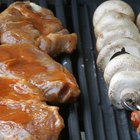
How to Use a Smoker Box for Gas Grilling

How to Make a Venison Rub

How to Soak Deer Meat in Baking Soda

How to Cook Turkey Legs on the Grill

How to Use Wood Chips in a Smoker

The Best Way to Smoke Yellowtail
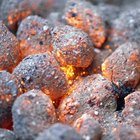
How to Cook Quail on a Grill
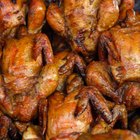
Rotisserie Cooking Times
How to Smoke Baby Back Ribs
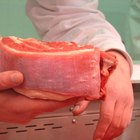
How to Cook Brisket on a Propane Grill

How to Tenderize Jerky
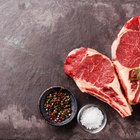
How to Cook Cowboy Cut Ribeye

How to Smoke a Brisket With an Offset ...
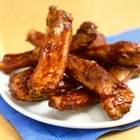
How to Bake Spare Ribs Before BBQing

How to Cook Deer Steaks in the Oven on ...

Reheating a BBQ Pork Shoulder
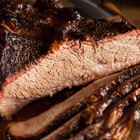
How to Steam a Brisket of Beef
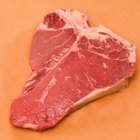
How to Score a Steak
References
- USDA: Fresh Pork from Farm to Table
- YouTube: How We Cooked a Whole Roast Suckling Pig on a Gas Grill
- Amazing Ribs: Goin' Whole Hog: What You Need To Know To Roast A Hog Or Suckling Pig
- Marinades, Rubs, Brines, Cures & Glazes; Jim Tarantino
Writer Bio
Diane Watkins has been writing since 1984, with experience in newspaper, newsletter and Web content. She writes two electronic newsletters and has a Bachelor of Science degree in chemistry from Clemson University. She has taken graduate courses in biochemistry and education.
Photo Credits
Hemera Technologies/Photos.com/Getty Images